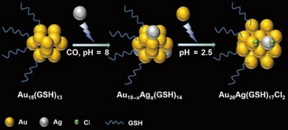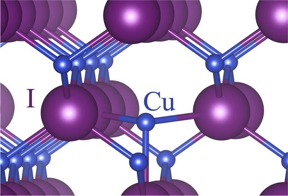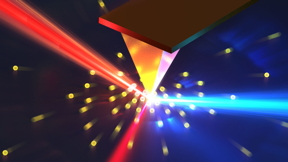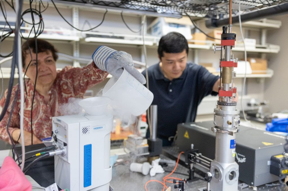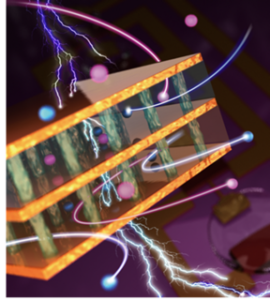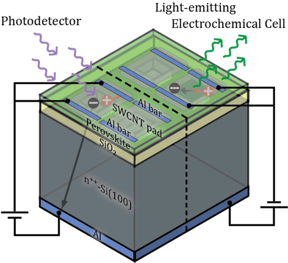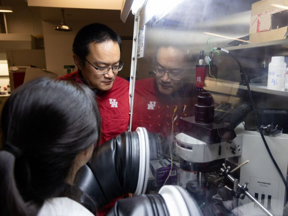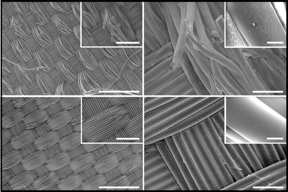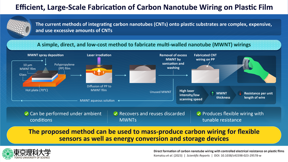Home > Press > Physicists ‘entangle’ individual molecules for the first time, hastening possibilities for quantum information processing: In work that could lead to more robust quantum computing, Princeton researchers have succeeded in forcing molecules into quantum entanglement
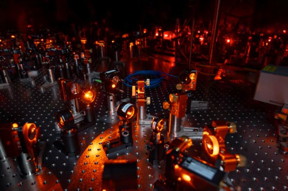 |
| Laser setup for cooling, controlling, and entangling individual molecules. CREDIT Photo by Richard Soden, Department of Physics, Princeton University |
Abstract:
For the first time, a team of Princeton physicists have been able to link together individual molecules into special states that are quantum mechanically “entangled.” In these bizarre states, the molecules remain correlated with each other—and can interact simultaneously—even if they are miles apart, or indeed, even if they occupy opposite ends of the universe. This research was recently published in the journal Science.
Physicists ‘entangle’ individual molecules for the first time, hastening possibilities for quantum information processing: In work that could lead to more robust quantum computing, Princeton researchers have succeeded in forcing molecules into quantum entanglement
Princeton, NJ | Posted on December 8th, 2023“This is a breakthrough in the world of molecules because of the fundamental importance of quantum entanglement,” said Lawrence Cheuk, assistant professor of physics at Princeton University and the senior author of the paper. “But it is also a breakthrough for practical applications because entangled molecules can be the building blocks for many future applications.”
These include, for example, quantum computers that can solve certain problems much faster than conventional computers, quantum simulators that can model complex materials whose behaviors are difficult to model, and quantum sensors that can measure faster than their traditional counterparts.
“One of the motivations in doing quantum science is that in the practical world it turns out that if you harness the laws of quantum mechanics, you can do a lot better in many areas,” said Connor Holland, a graduate student in the physics department and a co-author on the work.
The ability of quantum devices to outperform classical ones is known as “quantum advantage.” And at the core of quantum advantage are the principles of superposition and quantum entanglement. While a classical computer bit can assume the value of either 0 or 1, quantum bits, called qubits, can simultaneously be in a superposition of 0 and 1. The latter concept, entanglement, is a major cornerstone of quantum mechanics, and occurs when two particles become inextricably linked with each other so that this link persists, even if one particle is light years away from the other particle. It is the phenomenon that Albert Einstein, who at first questioned its validity, described as “spooky action at a distance.” Since then, physicists have demonstrated that entanglement is, in fact, an accurate description of the physical world and how reality is structured.
“Quantum entanglement is a fundamental concept,” said Cheuk, “but it is also the key ingredient that bestows quantum advantage.”
But building quantum advantage and achieving controllable quantum entanglement remains a challenge, not least because engineers and scientists are still unclear about which physical platform is best for creating qubits. In the past decades, many different technologies—such as trapped ions, photons, superconducting circuits, to name only a few—have been explored as candidates for quantum computers and devices. The optimal quantum system or qubit platform could very well depend on the specific application.
Until this experiment, however, molecules had long defied controllable quantum entanglement. But Cheuk and his colleagues found a way, through careful manipulation in the laboratory, to control individual molecules and coax them into these interlocking quantum states. They also believed that molecules have certain advantages—over atoms, for example—that made them especially well-suited for certain applications in quantum information processing and quantum simulation of complex materials. Compared to atoms, for example, molecules have more quantum degrees of freedom and can interact in new ways.
“What this means, in practical terms, is that there are new ways of storing and processing quantum information,” said Yukai Lu, a graduate student in electrical and computer engineering and a co-author of the paper. “For example, a molecule can vibrate and rotate in multiple modes. So, you can use two of these modes to encode a qubit. If the molecular species is polar, two molecules can interact even when spatially separated.”
Nonetheless, molecules have proven notoriously difficult to control in the laboratory because of their complexity. The very degrees of freedom that make them attractive also make them hard to control, or corral, in laboratory settings.
Cheuk and his team addressed many of these challenges through a carefully thought-out experiment. They first picked a molecular species that is both polar and can be cooled with lasers. They then laser-cooled the molecules to ultracold temperatures where quantum mechanics takes centerstage. Individual molecules were then picked up by a complex system of tightly focused laser beams, so-called “optical tweezers.” By engineering the positions of the tweezers, they were able to create large arrays of single molecules and individually position them into any desired one-dimensional configuration. For example, they created isolated pairs of molecules and also defect-free strings of molecules.
Next, they encoded a qubit into a non-rotating and rotating state of the molecule. They were able to show that this molecular qubit remained coherent, that is, it remembered its superposition. In short, the researchers demonstrated the ability to create well-controlled and coherent qubits out of individually controlled molecules.
To entangle the molecules, they had to make the molecule interact. By using a series of microwave pulses, they were able to make individual molecules interact with one another in a coherent fashion. By allowing the interaction to proceed for a precise amount of time, they were able to implement a two-qubit gate that entangled two molecules. This is significant because such an entangling two-qubit gate is a building block for both universal digital quantum computing and for simulation of complex materials.
The potential of this research for investigating different areas of quantum science is large, given the innovative features offered by this new platform of molecular tweezer arrays. In particular, the Princeton team is interested in exploring the physics of many interacting molecules, which can be used to simulate quantum many-body systems where interesting emergent behavior such as novel forms of magnetism can appear.
“Using molecules for quantum science is a new frontier and our demonstration of on-demand entanglement is a key step in demonstrating that molecules can be used as a viable platform for quantum science,” said Cheuk.
In a separate article published in the same issue of Science, an independent research group led by John Doyle and Kang-Kuen Ni at Harvard University and Wolfgang Ketterle at the Massachusetts Institute of Technology achieved similar results.
“The fact that they got the same results verify the reliability of our results,” Cheuk said. “They also show that molecular tweezer arrays are becoming an exciting new platform for quantum science.”
####
For more information, please click here
Contacts:
Catherine Zandonella
Princeton University
Office: 609-258-0541
Expert Contact
Lawrence W. Cheuk
Princeton University
@Princeton
Copyright © Princeton University
If you have a comment, please Contact us.Issuers of news releases, not 7th Wave, Inc. or Nanotechnology Now, are solely responsible for the accuracy of the content.
| Related Links |
| Related News Press |
News and information
![]() World’s first logical quantum processor: Key step toward reliable quantum computing December 8th, 2023
World’s first logical quantum processor: Key step toward reliable quantum computing December 8th, 2023
![]() VUB team develops breakthrough nanobody technology against liver inflammation December 8th, 2023
VUB team develops breakthrough nanobody technology against liver inflammation December 8th, 2023
![]() Finding the most heat-resistant substances ever made: UVA Engineering secures DOD MURI award to advance high-temperature materials December 8th, 2023
Finding the most heat-resistant substances ever made: UVA Engineering secures DOD MURI award to advance high-temperature materials December 8th, 2023
Quantum Physics
![]() Three-pronged approach discerns qualities of quantum spin liquids November 17th, 2023
Three-pronged approach discerns qualities of quantum spin liquids November 17th, 2023
![]() What a “2D” quantum superfluid feels like to the touch November 3rd, 2023
What a “2D” quantum superfluid feels like to the touch November 3rd, 2023
Physics
![]() What a “2D” quantum superfluid feels like to the touch November 3rd, 2023
What a “2D” quantum superfluid feels like to the touch November 3rd, 2023
Possible Futures
![]() World’s first logical quantum processor: Key step toward reliable quantum computing December 8th, 2023
World’s first logical quantum processor: Key step toward reliable quantum computing December 8th, 2023
![]() VUB team develops breakthrough nanobody technology against liver inflammation December 8th, 2023
VUB team develops breakthrough nanobody technology against liver inflammation December 8th, 2023
![]() Finding the most heat-resistant substances ever made: UVA Engineering secures DOD MURI award to advance high-temperature materials December 8th, 2023
Finding the most heat-resistant substances ever made: UVA Engineering secures DOD MURI award to advance high-temperature materials December 8th, 2023
Quantum Computing
![]() World’s first logical quantum processor: Key step toward reliable quantum computing December 8th, 2023
World’s first logical quantum processor: Key step toward reliable quantum computing December 8th, 2023
![]() A new qubit platform is created atom by atom October 6th, 2023
A new qubit platform is created atom by atom October 6th, 2023
![]() Discovery made by University of Warsaw scientists may enable network interface for quantum computers October 6th, 2023
Discovery made by University of Warsaw scientists may enable network interface for quantum computers October 6th, 2023
Discoveries
![]() Thermal impact of 3D stacking photonic and electronic chips: Researchers investigate how the thermal penalty of 3D integration can be minimized December 8th, 2023
Thermal impact of 3D stacking photonic and electronic chips: Researchers investigate how the thermal penalty of 3D integration can be minimized December 8th, 2023
![]() Presenting: Ultrasound-based printing of 3D materials—potentially inside the body December 8th, 2023
Presenting: Ultrasound-based printing of 3D materials—potentially inside the body December 8th, 2023
Announcements
![]() 2D material reshapes 3D electronics for AI hardware December 8th, 2023
2D material reshapes 3D electronics for AI hardware December 8th, 2023
![]() VUB team develops breakthrough nanobody technology against liver inflammation December 8th, 2023
VUB team develops breakthrough nanobody technology against liver inflammation December 8th, 2023
![]() Finding the most heat-resistant substances ever made: UVA Engineering secures DOD MURI award to advance high-temperature materials December 8th, 2023
Finding the most heat-resistant substances ever made: UVA Engineering secures DOD MURI award to advance high-temperature materials December 8th, 2023
Interviews/Book Reviews/Essays/Reports/Podcasts/Journals/White papers/Posters
![]() 2D material reshapes 3D electronics for AI hardware December 8th, 2023
2D material reshapes 3D electronics for AI hardware December 8th, 2023
![]() World’s first logical quantum processor: Key step toward reliable quantum computing December 8th, 2023
World’s first logical quantum processor: Key step toward reliable quantum computing December 8th, 2023
![]() VUB team develops breakthrough nanobody technology against liver inflammation December 8th, 2023
VUB team develops breakthrough nanobody technology against liver inflammation December 8th, 2023
Quantum nanoscience
![]() What a “2D” quantum superfluid feels like to the touch November 3rd, 2023
What a “2D” quantum superfluid feels like to the touch November 3rd, 2023
![]() A new qubit platform is created atom by atom October 6th, 2023
A new qubit platform is created atom by atom October 6th, 2023
![]() A quantum leap in mechanical oscillator technology August 11th, 2023
A quantum leap in mechanical oscillator technology August 11th, 2023
- SEO Powered Content & PR Distribution. Get Amplified Today.
- PlatoData.Network Vertical Generative Ai. Empower Yourself. Access Here.
- PlatoAiStream. Web3 Intelligence. Knowledge Amplified. Access Here.
- PlatoESG. Carbon, CleanTech, Energy, Environment, Solar, Waste Management. Access Here.
- PlatoHealth. Biotech and Clinical Trials Intelligence. Access Here.
- Source: http://www.nanotech-now.com/news.cgi?story_id=57430
- :is
- :not
- :where
- $UP
- 1
- 10
- 17th
- 2023
- 21st
- 28
- 3d
- 3rd
- 6th
- 7
- 7th
- 8
- 8th
- a
- ability
- Able
- About
- accuracy
- accurate
- achieved
- achieving
- Action
- addressed
- advance
- ADvantage
- against
- AI
- allen
- Allowing
- also
- amount
- an
- and
- Another
- any
- apart
- appear
- Application
- applications
- approach
- ARE
- areas
- around
- Array
- article
- AS
- Assistant
- assume
- At
- atom
- attractive
- AUGUST
- author
- autonomous
- award
- away
- based
- BE
- because
- become
- becoming
- been
- behavior
- believed
- BEST
- Better
- biology
- Bit
- Block
- Blocks
- both
- breakthrough
- Building
- but
- by
- called
- CAN
- candidates
- careful
- carefully
- Cells
- Center
- certain
- CGI
- challenge
- challenges
- chan
- Changes
- chemistry
- Chips
- click
- Co-Author
- COHERENT
- cold
- colleagues
- color
- COM
- comment
- compared
- complex
- complexity
- computer
- Computer Engineering
- computers
- computing
- concept
- conducted
- Configuration
- content
- contribution
- control
- controlled
- controlling
- conventional
- Core
- cornerstone
- correlated
- cost-effective
- could
- counterparts
- create
- created
- Creating
- credit
- dance
- decades
- December
- defied
- del
- delivery
- demonstrated
- demonstrating
- Department
- depend
- described
- description
- Design
- desired
- develop
- develops
- device
- Devices
- different
- difficult
- digital
- discover
- Disease
- distance
- do
- DoD
- doing
- dynamics
- each
- effects
- einstein
- either
- Electronic
- Electronics
- enable
- end
- ends
- Engineering
- Engineers
- especially
- Ether (ETH)
- Even
- EVER
- example
- exciting
- expected
- experiment
- experiments
- Explored
- Exploring
- fact
- Fashion
- faster
- Features
- feels
- fibers
- findings
- First
- first time
- focused
- For
- forcing
- forms
- found
- Freedom
- from
- Frontier
- fundamental
- future
- gate
- generating
- gif
- given
- got
- graduate
- Group
- had
- Hard
- harness
- harvard
- harvard university
- Have
- help
- helped
- his
- Holland
- How
- However
- http
- HTTPS
- Hub
- if
- Impact
- implement
- importance
- in
- Inc.
- include
- independent
- individual
- Individually
- inflammation
- information
- ingredient
- Initiative
- innovative
- inside
- Institute
- integration
- interact
- interacting
- interaction
- interested
- interesting
- Interface
- International
- international space station
- into
- investigate
- isolated
- issue
- IT
- ITS
- John
- journal
- July
- Key
- known
- lab
- laboratory
- large
- laser
- lasers
- launched
- lawrence
- Laws
- lead
- Leap
- least
- Led
- light
- like
- LINK
- linked
- links
- Liver
- logical
- Long
- Lot
- made
- Magnetism
- major
- make
- Manipulation
- many
- massachusetts
- Massachusetts Institute of technology
- material
- materials
- May..
- means
- measure
- mechanical
- mechanics
- model
- modes
- molecular
- molecule
- more
- most
- motivations
- mRNA
- much
- multiple
- name
- nanotechnology
- Nature
- net
- network
- New
- New Platform
- news
- next-generation
- nexus
- nicholas
- novel
- November
- now
- nuclear
- october
- of
- offered
- on
- On-Demand
- ONE
- ones
- only
- opposite
- optimal
- or
- Other
- our
- out
- Outperform
- pairs
- Paper
- particle
- particular
- past
- pave
- persists
- phenomenon
- photo
- Photons
- PHP
- physical
- Physics
- picked
- platform
- plato
- Plato Data Intelligence
- PlatoData
- please
- polar
- position
- positions
- possibilities
- Post
- posted
- potential
- Practical
- Practical Applications
- precise
- press
- Press Release
- princeton
- principles
- printing
- probe
- problems
- proceed
- processing
- Processor
- Professor
- prompts
- proven
- published
- qualities
- Quantum
- quantum advantage
- quantum computers
- quantum computing
- quantum entanglement
- quantum information
- Quantum Mechanics
- Quantum sensors
- Qubit
- qubits
- Questioned
- Reality
- recently
- recording
- reduces
- release
- Releases
- reliability
- reliable
- remain
- remained
- remains
- research
- research group
- researchers
- responsible
- Results
- return
- reveal
- Revealed
- Richard
- robots
- robust
- Room
- s
- Said
- same
- Save
- Science
- scientists
- Search
- secrets
- Secures
- senior
- sense
- Sensitivity
- sensor
- sensors
- separate
- Series
- settings
- setup
- Share
- Short
- show
- Shows
- significant
- similar
- simulation
- simultaneously
- since
- single
- Skin
- So
- Soft
- solely
- SOLVE
- Source
- Space
- space station
- special
- specific
- Spin
- stacking
- start
- State
- States
- station
- Step
- Still
- structured
- Student
- Study
- submit
- such
- superposition
- synthetic
- system
- Systems
- takes
- team
- Technologies
- Technology
- terms
- than
- that
- The
- the world
- their
- Them
- then
- There.
- thermal
- These
- they
- this
- Through
- tightly
- time
- to
- together
- tools
- toronto
- toward
- traditional
- trapped
- TURN
- turns
- two
- unclear
- Universal
- Universe
- university
- university of washington
- unlock
- us
- use
- used
- uses
- using
- Vaccine
- value
- verify
- very
- viable
- W
- Warsaw
- was
- washington
- Wave
- Way..
- ways
- wearable
- WELL
- were
- when
- which
- while
- WHO
- whose
- will
- with
- Work
- world
- Yahoo
- years
- you
- zephyrnet
- Zuckerberg










